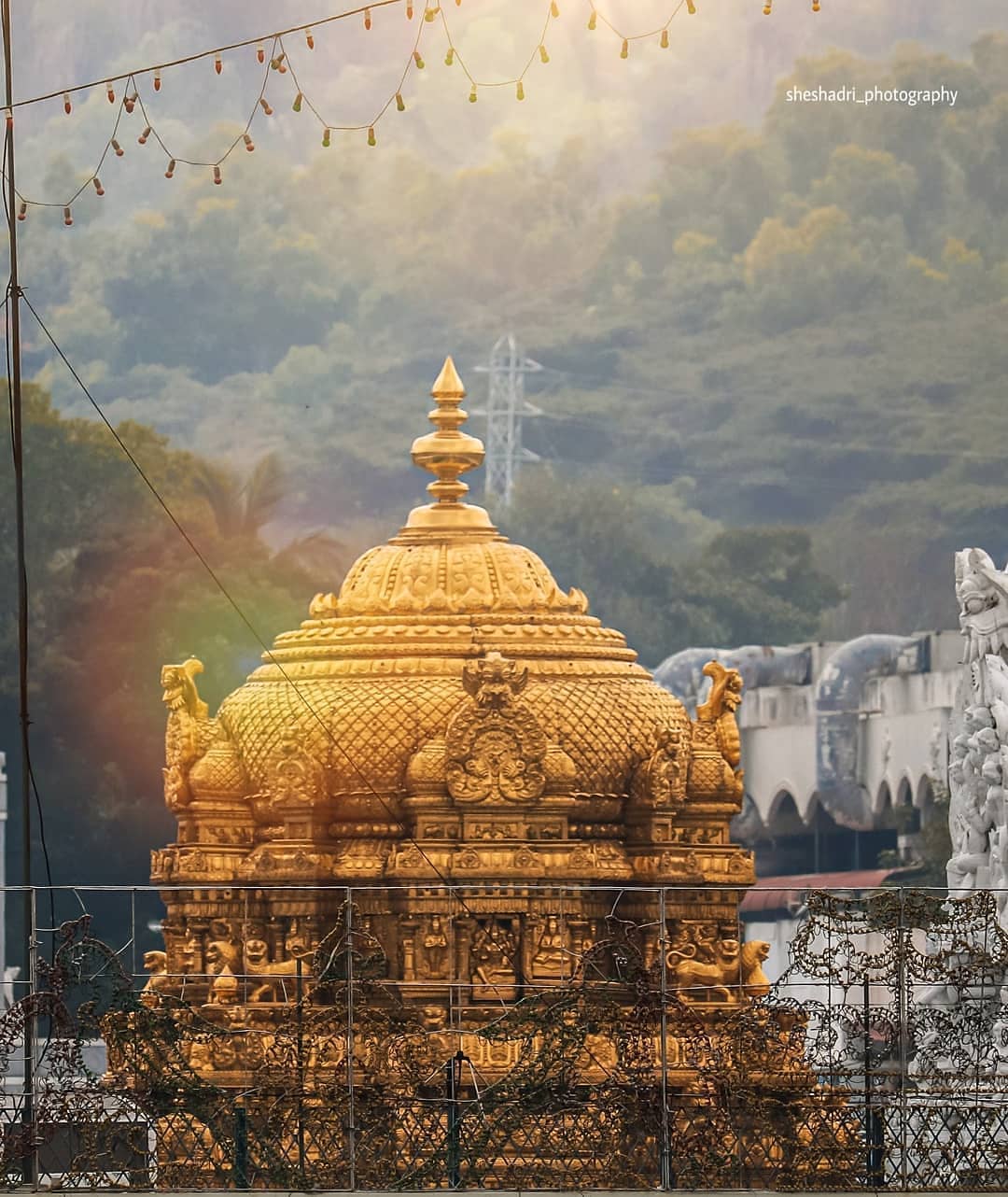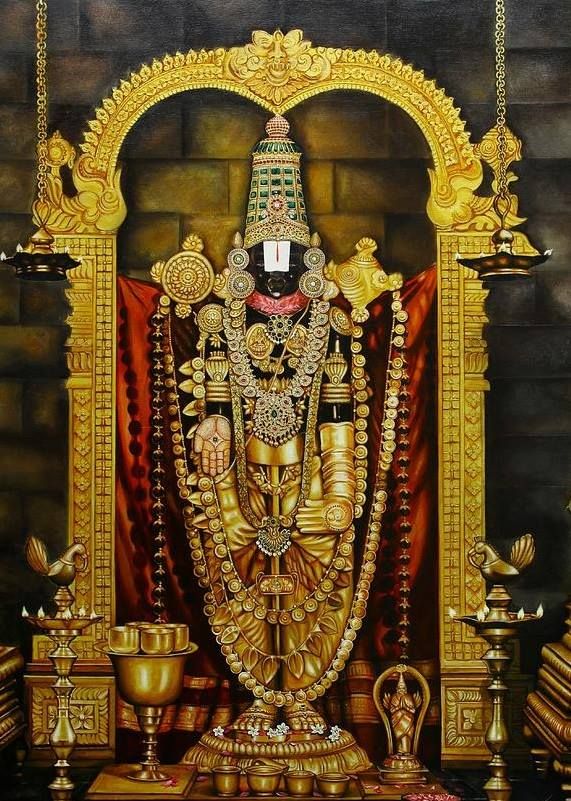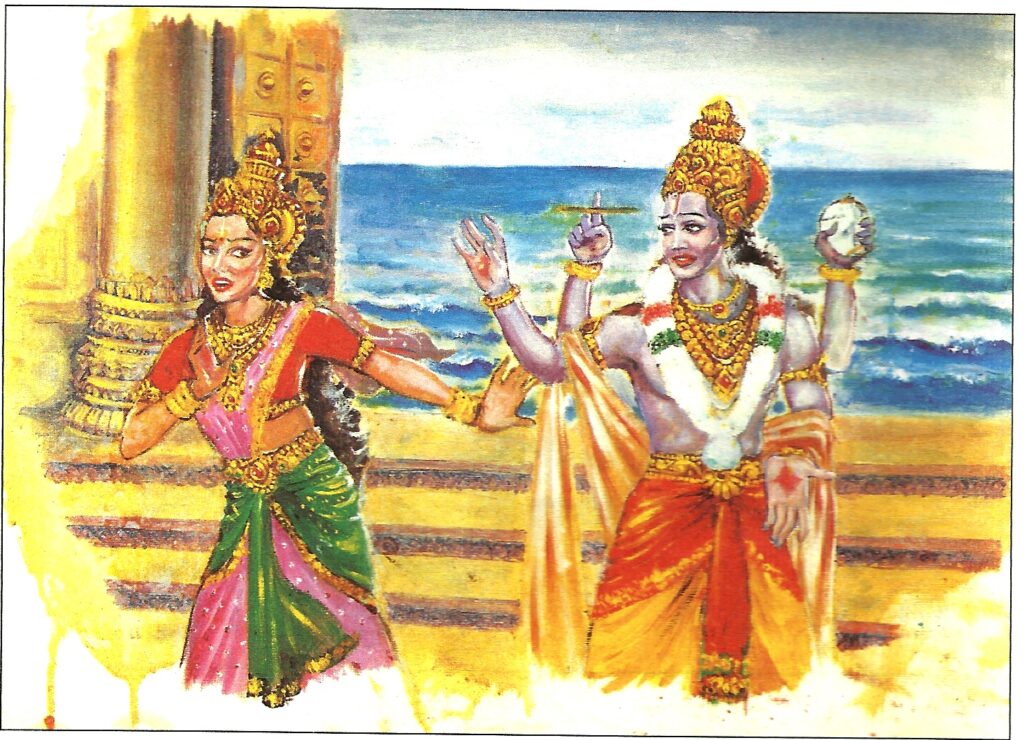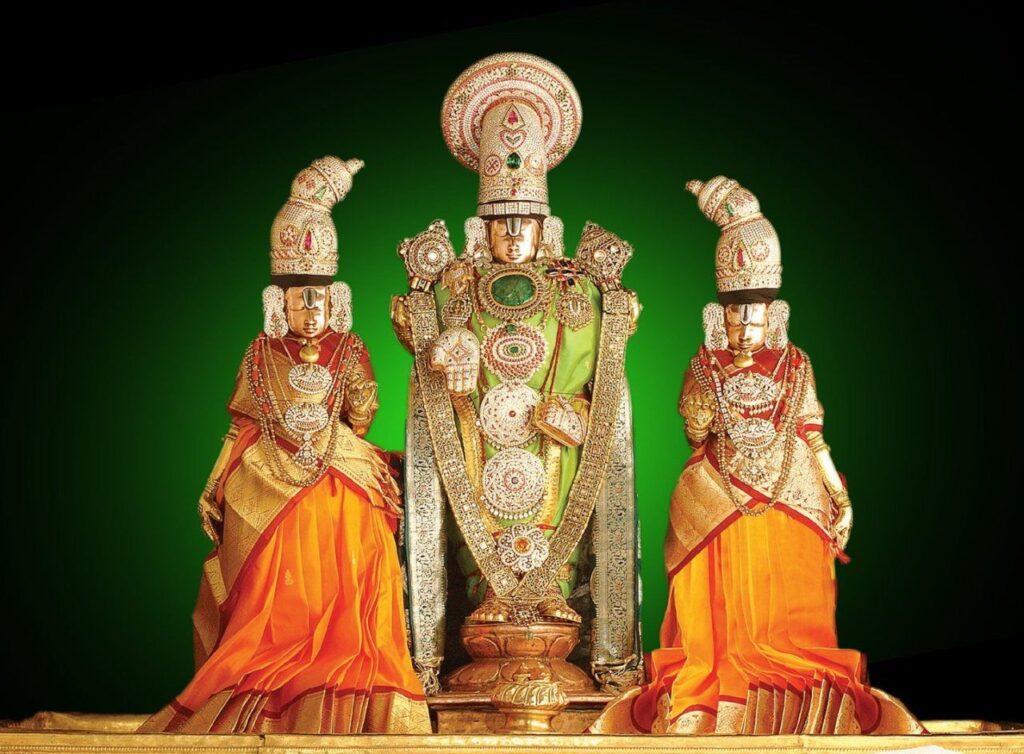
Sri Venkateshwara Swamy Temple also widely known as Tirupati Balaji Temple or Sri Srinivasa Govinda Temple is the most famed temple in India. It attracts one of the largest crowds in the country along with Vaishno Devi Temple. It is the second richest temple and the busiest pilgrimage site on earth.
Sri Venkateshwara Swamy Temple is revered as the 75th Divya Desham called as Tiruvenkadam. It is located atop the transcendentally beautiful and sacred hills of Tirumala in the Tirupati district of Andhra Pradesh (India). The mesmerizing and transcendentally opulent Deity of Venkateshwara Swamy attracts the mind and heart of people worldwide. His appearance is described as follows:
bhavabdhitaram kativartihastam swarnabharam rathnakireetakundalam
alambisootrotthama malyabhooshitham namamyaham venkata shailanasyakam
I worship Lord Venkateshwara, the Lord of the seven hills who is standing with His hands in varada mudra and kati mudra, who is adorned with golden jewels, who sports a golden crown with golden dangling earrings. He is always wearing a garland of fresh fragrant flowers. He is the source of bliss.
Even when the darshan of Lord Venkateshwara is closed, one or more of the temple departments functions round the clock. Devotees flock to the temple in numbers nearing a lakh daily going up further on festive occasions. The Sri Venkateshwara Swamy Temple activities are huge to the extent that it functions almost like a government.
The Sri Venkateshwara Swamy Temple sits atop the Venkatadri hill among the seven hills of Tirumala. In the Skanda Purana, Venkatadri is described as a golden mountain filled with jewels and gems. Hence, it could be said that the Sri Venkateshwara Swamy Temple appears to be a gem set on a golden locket. Venkatadri is also known as Venkatachalam.
One thing that devotees going to the temple remember without fail is the Laddoo prasadam of Venkateshwara Swamy. This is world famous and yearned by devotees visiting the temple. The Laddoo prasadam here is GI (Geographical Indication) tagged which implies that only the Sri Venkateshwara Swamy Temple has exclusive rights to make it and call it Tirupati Laddoo.
The main tirtha for the temple is Swami Pushkarini which has been there since time immemorial.
The pradurbhava lila of Sri Venkateshwara Swamy Temple
The lila of the appearance of Venkateshwara Swamy on Venkatadri has been mentioned in the Vedic texts such as the Venkatachala Mahatmya of Skanda Purana. Just like the appearance of the various avataras of Lord Vishnu, the lila of the appearance of Venkateshwara Swamy is very uncommon and highly relishing to the ear. Hearing it removes the fear you face in this world.
At the beginning of the 28th Kali Yuga, Lord Vishnu, Who was living atop the sacred Venkatadri Hill went back to Vaikuntha. Being sad at this, Lord Brahma asked Sage Narada to convince Lord Vishnu to return to Venkatadri. Sage Narada went to the banks of the sacred Ganga where a group of Sages were performing a grand yagna. They were in dilemma as to who should receive the results of the yagna among the Trimurtis i.e. Lord Brahma, Lord Vishnu and Lord Shiva.
The famous Sage Bhrigu took this task upon himself to determine the recipient of the results of the yagna. He set out to the abodes of the Trimurtis one by one. In Brahmaloka and on Mt. Kailasa, Lord Brahma and Lord Shiva were busy with their activities respectively and hence, failed to notice the Sage. Finally, as part of the test, Sage Bhrigu kicked the lotus chest of Lord Vishnu, where Lakshmi Devi was reclining in Vaikuntha.
Instead of getting angry on Sage Bhrigu, Lord Vishnu got up, massaged the Sage’s feet and apologised that the Sage’s feet would have got hurt from kicking His lotus chest. Finally, the Sage knew the true recipient of the yagna results. He went back and advised the other Sages at the banks of the Ganga to dedicate the results of the yagna to Lord Vishnu.
In the meantime, Lakshmi Devi, who was angry with Sage Bhrigu’s action, left Vaikuntha for earth and started engaging in penances at Karavirapura (present day Kolhapur in Maharashtra). Lord Vishnu started feeling lonely in Vaikuntha without Lakshmi Devi even though all His servants were there at His service. He left Vaikuntha and started roaming the hills and forests on earth.
Lord Vishnu Resides on Venkatadri
Lord Vishnu was not able to find His dear consort Lakshmi Devi anywhere. Frustrated, He took up residence in an ant-hill underneath a Tamarind tree on the banks of the Swami Pushkarini on Venkatadri Hill. Seeing the condition of Lord Vishnu, Lord Brahma and Lord Shiva took the form of a cow and calf to serve Him.
After assuming the forms of cow and calf, Suryadeva informed Lakshmi Devi about the situation and asked Her to sell them to the Chola King. Lakshmi Devi did as told and the Chola King took their possession. The King sent them to graze with a cowherd man on the Venkatadri Hill.
Discovering Lord Vishnu in an ant-hill on Venkatadri Hill, the cow emptied the milk in its udder on the ant-hill to feed Lord Vishnu. The cow would do this everyday when it would come up to graze on the Venkatadri Hill. After sometime, the Queen noticed that the cow came back every day with an empty udder. She reprimanded the cowherd man for the same.
To investigate the matter, the cowherd man followed this particular cow. At the ant-hill, he saw the cow emptying its udder. Being shocked at this, he went up to the cow and lifted his axe to hit the cow. But the axe hit the lotus head of Lord Vishnu Who interfered to protect the cow. The Lord started bleeding, seeing which, the cowherd man fell down and died.
The cow, on being saved by Lord Vishnu, went back to the Chola King stained with blood and started bellowing. The King followed the cow back to the ant-hill where the cowherd man was found dead. While he was puzzled by the events that had happened there, Lord Vishnu rose from the ant-hill and cursed the king to become an asura for the fault of his servant.
The King, who pleaded innocence was blessed by the Lord saying that he would become free from the curse when the Lord would be adorned with a crown presented by Akasha Raja at His marriage with Padmavati Devi. As he died, the cowherd man and his descendants were blessed with the benediction of opening the Garbhagriha door of Venkateshwara Swamy in the future. Following this, Lord Vishnu went to stay with His foster-mother Vakula Devi on Venkatadri.
Lord Vishnu Weds Padmavati Devi
Vakula Devi was His foster mother Yashoda Devi in His Krishna avatara. As Yashoda Devi, she was unhappy that she could not witness Lord Krishna’s wedding. Hence, Lord Krishna had blessed her with the benediction of witnessing His wedding during His future lila on Venkatadri.
In his next birth, the Chola King was born as Akasha Raja. He found a baby girl on a lotus flower while ploughing a field to prepare for a yagna. As the king had no child of his own, he was extremely happy and took the child to his wife. He named her Padmavati as she appeared on a lotus flower.
Padmavati grew into a beautiful young maiden. One day, Sage Narada arrived at her palace and told her that she would get Lord Vishnu as her husband after reading her palm. Later, Lord Vishnu saw Padmavati in a garden when He was chasing a wild elephant. Ever since then, He could not rest peacefully.
Padmavati’s condition was no less different. On knowing the condition of Lord Vishnu, Vakula Devi went to meet Akasha Raja and conveyed the Lord’s desire to marry Padmavati Devi. The King, who was delighted to hear that Lord Vishnu desired his daughter’s hand in marriage agreed to the proposal with great happiness.
After fixing a muhurtam (auspicious time) in consultation with Brihaspati, the chief priest of the devatas, the grand wedding ceremony of Lord Vishnu and Padmavati Devi was performed with great fanfare amidst the presence of the devatas and other denizens of the universe.
When Lakshmi Devi came to know this, She went to Lord Vishnu questioning His marriage to Padmavati Devi, who arrived on the scene too. A quarrel broke out, seeing which, Lord Vishnu accepted the Deity form. Lord Brahma and Lord Shiva appeared on the scene and conveyed the desire of Lord Vishnu to stay on the Venkatadri Hill eternally for the benefit of the world in Kali Yuga.
On hearing the same, both the consorts of the Lord expressed their desire to stay with Him eternally and thus, accepted the Deity forms. Since then, Lord Vishnu has reigned on Venkatadri as Venkateshwara Swamy along with His consorts Lakshmi Devi and Padmavati Devi, blessing devotees.
Deities of Sri Venkateshwara Swamy Temple
The Deities of the Sri Venkateshwara Swamy Temple are worshipped as per the Vaikhanasa Agama tradition. Venkateshwara Swamy resides as Pancha Bera (Five Deities) in the Garbhagriha. This includes His Moola Vigraha (Main Deity). They are as follows –
Dhruva Beram
This is the Moolavar (Main) Deity of Venkateshwara Swamy. He has four lotus arms holding the Shanka and Chakra while standing on a lotus-base. His lower-right lotus hand depicts the Varada Mudra and His lower-left lotus hand depicts the Kati Mudra. Lakshmi Devi resides on His left lotus chest marked by the Srivatsa while Padmavati Devi resides on His right lotus chest.
He adorns the Sri Vaishnava Namam (tilak) on His lotus forehead and the Yagnopaveetham (sacred thread) on His lotus body. He adorns His lotus body with ornaments such as Kaustubham, Vajra Kiritam (diamond crown), Makarakundalas, Nagabharana, Makara Kanti, Shaligrama Garland and Lakshmi Garland. He is always adorned gorgeously with a variety of flower garlands as Venkateshwara Swamy loves them.
Kautuka Beram
This is a one-foot (0.3 m) silver-Deity of Bhoga Srinivasa used for festivals. It was gifted by the Pallava Queen Samavai in 614 CE. He resides near the left lotus feet of Dhruva Beram and is always connected to the main Deity by a Sambandha Kroocha. He receives many daily sevas on behalf of the main Deity and hence, called Bhoga Srinivasa.
Snapana Beram
This Deity is known as Ugra Srinivasa. He represents the fearsome form of Venkateshwara Swamy. He was the main processional Deity till 1330 CE. He was replaced by Malayappa Swamy as He would burn down the places He would travel through.
Nowadays, He comes out only once in a year from the Garbhagriha on the Kaishika Dwadashi day before sunrise. He receives daily abhishekam on behalf of the main Deity.
Utsava Beram
Sri Malayappa Swami is the Utsava Beram (Festival Deity) of the temple flanked by His consorts Sridevi and Bhudevi on either side. He is the luckiest Deity as He receives the sevas of all festivals at the temple 365 days a year. One such example is the daily Kalyanotsavam.
Bali Beram
Koluvu Srinivasa is the Bali Beram. He is the guardian Deity of the temple Who looks after its financial and economic matters. All accounts of the temple are read out to Koluvu Srinivasa every day at the Koluvu seva. The daily Panchangam is also read out before Koluvu Srinivasa.
Other Deities
In the Garbhagriha, the Deities of Sita Devi, Lord Rama, Lakshmana, Rukmini Devi, Lord Krishna and Sudarshana Chakra reside along with the Pancha Beramulu. The deities of the Dwarapalakas Jaya and Vijaya stand on either side of the Garbhagriha entrance.
In the sub-shrines, there are Deities of Sri Varadaraja, Sri Yoga Narasimha, Garudadeva, Bhakta Hanuman, Sri Adi-Shesha, Vishwaksena, Kubera, Sugriva, Angada and Sri Ramanujacharya.
The Deity of Vimana Venkateshwara is present on the second-tier of the Ananda Nilayam Vimana atop the Garbhagriha. Having His darshan is equal to having the darshan of the main Deity.
Architecture of Sri Venkateshwara Swamy Temple
The Sri Venkateshwara Swamy Temple has been constructed using the Dravidian style of architecture. As per the Venkatachala Mahatmya in the Skanda Purana, King Tondaman had built the first rampart wall with an ornamented gateway and doors around the cave where Venkateshwara Swamy resided. This was done as per the instructions of Venkateshwara Swamy.
The Lord also said that a king by the name of Narayana from the lineage of King Tondaman would build the temple adorning it with gold. The construction of the Sri Venkateshwara Swamy Temple is said to have begun in the year 300 CE with regular contributions and expansions by many kings spanning multiple dynasties.
There are three entrances to the Garbhagriha of Sri Venkateshwara Swamy Temple. The first entrance is called Mahadwaram, Simhadwaram or Padivakili which goes through the outer compound wall called Maha Prakaram. On top of this Mahadwaram is a 50-feet, five-tiered Gopuram with seven Kalashas on its top.
The second entrance is called Vendivakili (Silver Entrance) or Nadimipadivakili, which goes through the inner compound wall called Sampangi Prakaram. On the top of Vendivakili is a three-tiered Gopuram with seven Kalashas atop.
The third golden entrance Bangaruvakili flanked by the Dwarapalakas leads to the Garbhagriha which houses the Deities of Venkateshwara Swamy and other smaller Deities. This is a thick wooden door which is gold-plated and carved with the Dashavataras of Lord Vishnu. There are two more doors in-between Bangaruvakili and Garbhagriha.
The Vimanam of Venkateshwara Swamy is called Ananda Nilayam. It is three-storied with gold plating and holds a Kalasha on its top. There are many deities carved on it including Vimana Venkateshwara.
Visiting devotees are not allowed beyond the Kulashekara Padi which lies before the Garbhagriha. It was made to honour the Azhwar and Chera King Kulashekara Perumal who desired to be a step at least on Tirumala. Sevas which can’t be done in the Garbhagriha are performed here.
The Sri Venkateshwara Swamy Temple complex has two Pradakshinam paths to circumambulate Venkateshwara Swamy and pay respects to the deities in the sub-shrines. The first path is called Sampangi Pradakshinam which lies in-between Maha Prakaram and Sampangi Prakaram. It contains Mandapams, Balipeetam, Dhwajastambham, Kshetrapalika Shila, Prasadam distribution area, etc.
The second Pradakshinam is called Vimana Pradakshinam which goes around the Ananda Nilayam Vimanam. It contains the seat of Vishwaksena, the sub-shrines of Yoga Narasimha and Varadaraja Perumal, Main Kitchen, Sannidhi Bhashyakarulu, Srivari Hundi, Records Cell, Chandanapu Ara, Yagashala, Bangaru Bavi (Golden well), Ankurarpana Mandapam, Nanala Parkamani and Notla Parkamani. The small temples in this path are called Chuttu Gullu i.e. sub-shrines encircling the main temple.
There are many mandapams at the Sri Venkateshwara Swamy Temple such as Krishnadevarayala Mandapam, Addala Mandapam, Ranganayaka Mandapam, Tirumalaraya Mandapam, Dhwajastambha Mandapam, Four-Pillar Mandapam, Kalyanotsava Mandapam, Ugranam (Store House), Ghanta Mandapam, Garuda Mandapam, Snapana Mandapam, and Shayana Mandapam.
Festivals of Sri Venkateshwara Swamy Temple
The Sri Venkateshwara Swamy Temple abounds in festivals. Around 433 festivals are celebrated over a period of 365 days in a year. You could say that every day is a festival at Tirumala. Isn’t that wonderful?
Srivari Brahmotsavam is the main festival celebrated here spanning nine days in October. The Utsavar Vigrahas of Lord Venkateshwara i.e. Malayappa Swami and His consorts Sridevi and Bhudevi are taken through the four mada streets surrounding the Sri Venkateshwara Swamy Temple in special vahanams like Garuda Vahanam, Hanumantha Vahanam, Gajavahanam and many more vahanams.
Vaikuntha Ekadashi is another major and very important festival celebrated at the Sri Venkateshwara Swamy Temple. A grand Vaikuntha Dwaram is created encircling the Garbhagriha through which lakhs of devotees pass. This festival celebrates the entry of Nammazhwar, one of the 12 Azhwars into Vaikuntha on the Ekadashi day of Shukla Paksha Margali month.
Rathasapthami is celebrated during February, when Lord Malayappa Swami along with Sridevi and Bhudevi are taken on a special procession around the Sri Venkateshwara Swamy Temple in seven different vahanams from morning to night.
The other major festivals include Janmashtami, Rama Navami, Theppotsavam (Float Festival), Ugadi, Pushpa Yagam, Pushpa Pallaki, Vasanthotsavam (Spring Festival) and Sri Padmavati Parinayotsavams.
The Kalyanotsavam of Malayappa Swami with Sridevi and Bhudevi happens every morning. Devotees celebrate this festival every day at the Sri Venkateshwara Swamy Temple.
In this way, many festivals happen on the top of Tirumala hill daily.
Temple Timings of Sri Venkateshwara Swamy Temple
Sri Venkateshwara Swamy Temple is open for most of the time in a day. There is no fixed time for darshan. The general darshan is called ‘Sarvadarshanam’ whose timings change every day.
The Sarvadarshanam is open up to 18 hours in a day and could be extended up to 20 hours on peak days. The entrance for this darshan is through the Vaikuntam Que Complex.
You will have to refer to the weekly Sri Venkateshwara Swamy Temple programme published by TTD for specific information.
Best time to visit Sri Venkateshwara Swamy Temple
The Sri Venkateshwara Swamy Temple is always teeming with devotees irrespective of climate.
November to February sees a pleasant climate on Tirumala. If climate is an issue, you could always opt to travel during this period. Else, you are free to travel any time.
How to reach Sri Venkateshwara Swamy Temple
Being the largest pilgrimage site on earth, you will find many options to reach Sri Venkateshwara Swamy Temple located atop Tirumala hill in Tirupati district. Once you reach Tirupati city, there are free bus services run by the Tirumala Tirupati Devasthanams to Alipiri Gate, the entrance to Tirumala at its foothill. This is useful if you intend to climb the hill to the Sri Venkateshwara Swamy Temple. You will have to cover 3550 steps overall to reach the top.
If you are visiting the Srinivasa Mangapuram temple in the city or present in the area around this temple, you can reach the Sri Venkateshwara Swamy Temple via the Srivari Mettu Gate starting from the temple.
Alternatively, there are direct bus services from the Srinivasam Complex opposite the Tirupati Bus Station to Tirumala every 30 minutes. The 22 km distance to the Sri Venkateshwara Swamy Temple is covered in 45 minutes.
These options will help you reach Tirupati City –
By Road: Tirupati is well-connected to the rest of India via state and national highways. You will find state and private bus services plying between Tirupati and major cities such as Chennai, Bengaluru, Hyderabad, etc. Even taxi services are available from neighbouring states. Chennai is the nearest city 134 km away.
By Rail: Tirupati Main Railway Station (TPTY), located in TATA Nagar serves Tirupati. With the proposed upgradation of the station, devotees will see more train services and access to better facilities.
By Air: Tirupati International Airport (TIR), located in Renigunta serves Tirupati on domestic destinations. Till the time international flights start, your nearest international airport is the Chennai International Airport 146 km away.
Sri Venkateshwara Swamy Temple is a beacon of hope for those who wish to receive the utlimate shelter of Supreme Lord Sri Vishnu and achieve liberation from the cycle of birth and death.
0













Leave a Reply